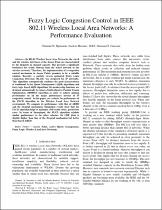 ResearchSpace
ResearchSpace
Fuzzy logic congestion control in IEEE 802.11 wireless local area networks: A performance evaluation
JavaScript is disabled for your browser. Some features of this site may not work without it.
- ResearchSpace
- →
- Research Publications/Outputs
- →
- Conference Publications
- →
- View Item
| dc.contributor.author |
Nyirenda, CN

|
|
| dc.contributor.author |
Dawoud, DS

|
|
| dc.date.accessioned | 2009-01-09T12:17:19Z | |
| dc.date.available | 2009-01-09T12:17:19Z | |
| dc.date.issued | 2007-09 | |
| dc.identifier.citation | Nyirenda, CN and Dawoud, DS. 2007. Fuzzy logic congestion control in IEEE 802.11 wireless local area networks: A performance evaluation. IEEE Africon Conference 2007. Windhoek, Namibia. 26-28 September, pp 6. | en |
| dc.identifier.isbn | 0-7803-8606-X | |
| dc.identifier.uri | http://hdl.handle.net/10204/2793 | |
| dc.description | Copyright: 2007 IEEE | en |
| dc.description.abstract | In 802.11 Wireless Local Area Networks, the wired and the wireless interfaces of the Access Point are characterized by the disparity in channel capacity. This presents a significant bottleneck for traffic flowing from the wired network to the wireless network. Therefore, the implementation of a congestion control mechanism in Access Points promises to be a suitable solution. Recently, a particle swarm optimized Fuzzy Logic Congestion Detection (FLCD) was proposed for IP networks. This algorithm synergistically combines the good characteristics of traditional Active Queue Management (AQM) algorithms and fuzzy logic based AQM algorithms. Its membership functions are designed automatically by using a Multi-objective Particle Swarm Optimization (MOPSO) algorithm in order to achieve optimal performance on all the major performance metrics of IP congestion control. In this paper, the authors evaluate the performance of the FLCD algorithm in the Wireless Local Area Network environment. They compare its performance with that of ARED and the Droptail mechanism. Simulation results show that the FLCD algorithm helps to minimize UDP traffic delay, packet loss rates. In terms of throughput, the FLCD algorithm exhibits similar performance to the other schemes. Its UDP jitter is slightly higher than that of the Droptail mechanism but better than that of ARED. | en |
| dc.language.iso | en | en |
| dc.publisher | IEEE | en |
| dc.subject | Fuzzy logic | en |
| dc.subject | Active queue management | en |
| dc.subject | Wireless LAN | en |
| dc.subject | IEEE Africon 2007 | en |
| dc.title | Fuzzy logic congestion control in IEEE 802.11 wireless local area networks: A performance evaluation | en |
| dc.type | Conference Presentation | en |
| dc.identifier.apacitation | Nyirenda, C., & Dawoud, D. (2007). Fuzzy logic congestion control in IEEE 802.11 wireless local area networks: A performance evaluation. IEEE. http://hdl.handle.net/10204/2793 | en_ZA |
| dc.identifier.chicagocitation | Nyirenda, CN, and DS Dawoud. "Fuzzy logic congestion control in IEEE 802.11 wireless local area networks: A performance evaluation." (2007): http://hdl.handle.net/10204/2793 | en_ZA |
| dc.identifier.vancouvercitation | Nyirenda C, Dawoud D, Fuzzy logic congestion control in IEEE 802.11 wireless local area networks: A performance evaluation; IEEE; 2007. http://hdl.handle.net/10204/2793 . | en_ZA |
| dc.identifier.ris | TY - Conference Presentation AU - Nyirenda, CN AU - Dawoud, DS AB - In 802.11 Wireless Local Area Networks, the wired and the wireless interfaces of the Access Point are characterized by the disparity in channel capacity. This presents a significant bottleneck for traffic flowing from the wired network to the wireless network. Therefore, the implementation of a congestion control mechanism in Access Points promises to be a suitable solution. Recently, a particle swarm optimized Fuzzy Logic Congestion Detection (FLCD) was proposed for IP networks. This algorithm synergistically combines the good characteristics of traditional Active Queue Management (AQM) algorithms and fuzzy logic based AQM algorithms. Its membership functions are designed automatically by using a Multi-objective Particle Swarm Optimization (MOPSO) algorithm in order to achieve optimal performance on all the major performance metrics of IP congestion control. In this paper, the authors evaluate the performance of the FLCD algorithm in the Wireless Local Area Network environment. They compare its performance with that of ARED and the Droptail mechanism. Simulation results show that the FLCD algorithm helps to minimize UDP traffic delay, packet loss rates. In terms of throughput, the FLCD algorithm exhibits similar performance to the other schemes. Its UDP jitter is slightly higher than that of the Droptail mechanism but better than that of ARED. DA - 2007-09 DB - ResearchSpace DP - CSIR KW - Fuzzy logic KW - Active queue management KW - Wireless LAN KW - IEEE Africon 2007 LK - https://researchspace.csir.co.za PY - 2007 SM - 0-7803-8606-X T1 - Fuzzy logic congestion control in IEEE 802.11 wireless local area networks: A performance evaluation TI - Fuzzy logic congestion control in IEEE 802.11 wireless local area networks: A performance evaluation UR - http://hdl.handle.net/10204/2793 ER - | en_ZA |





